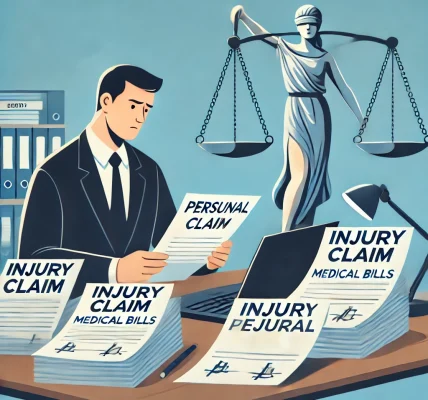- Introduction
When an individual suffers harm due to someone else’s actions, they may be entitled to compensation through a personal injury claim. However, not all personal injury cases are the same. Two common legal claims are medical malpractice and personal injury, both of which involve seeking compensation for harm suffered.
While these claims may seem similar, there are crucial legal distinctions between them. Understanding these differences is essential for determining the appropriate legal action, ensuring fair compensation, and avoiding unnecessary legal complications.
In this article, we will explore the key legal differences between medical malpractice and personal injury claims, including definitions, burden of proof, types of damages, and the legal processes involved.
What Is Personal Injury?
A personal injury claim arises when a person is injured due to another party’s negligence, recklessness, or intentional misconduct. The primary objective of a personal injury lawsuit is to recover compensation for physical, emotional, and financial damages caused by the accident.
Common Types of Personal Injury Cases:
- Car accidents (including hit-and-run and DUI-related accidents)
- Slip and fall accidents (premises liability cases)
- Workplace injuries
- Defective product injuries (product liability claims)
- Assault and battery
To succeed in a personal injury claim, the plaintiff (injured party) must prove that the defendant acted negligently and that their negligence directly caused the injury.
What Is Medical Malpractice?
Medical malpractice is a specialized category of personal injury law that applies when a healthcare professional fails to provide the standard level of care, resulting in harm to the patient.
Common Types of Medical Malpractice Cases:
- Misdiagnosis or delayed diagnosis
- Surgical errors (wrong-site surgery, leaving medical instruments inside the patient, etc.)
- Medication errors (wrong prescription or incorrect dosage)
- Birth injuries (injuries to mother or child during delivery)
- Anesthesia errors
- Failure to obtain informed consent
Medical malpractice cases require proving that a healthcare provider deviated from the accepted medical standard of care and that this deviation directly caused harm.
Key Legal Differences Between Medical Malpractice and Personal Injury
1. Burden of Proof
- In personal injury cases, the plaintiff must prove that the defendant’s negligence caused their injury. The standard of proof is typically “preponderance of the evidence,” meaning it is more likely than not that the defendant is responsible.
- In medical malpractice cases, proving negligence is more complex because the plaintiff must demonstrate that the medical professional’s actions deviated from the accepted standard of care in their field.
2. Standard of Care
- In personal injury cases, the defendant’s behavior is compared to what a “reasonable person” would do in a similar situation.
- In medical malpractice cases, the defendant’s actions are compared to the standards set by the medical profession. Expert testimony is often required to establish the correct standard of care and prove that the defendant failed to meet it.
3. Use of Expert Witnesses
- Personal injury cases may involve experts, but they are not always necessary. The facts of the case (e.g., eyewitness testimony, video evidence) often speak for themselves.
- Medical malpractice cases almost always require expert medical witnesses to explain how the healthcare provider’s actions deviated from accepted medical practices.
4. Legal Procedures and Filing Requirements
- Medical malpractice claims often have stricter filing requirements, including:
- Pre-suit notice requirements
- Certificate of merit (expert opinion supporting the claim)
- Shorter statute of limitations in some states
- Personal injury claims generally have fewer procedural hurdles and longer filing deadlines, depending on the type of injury and jurisdiction.
5. Types of Compensation Available
Both medical malpractice and personal injury claims allow victims to seek compensation for:
- Economic damages (medical expenses, lost wages, rehabilitation costs)
- Non-economic damages (pain and suffering, emotional distress, loss of enjoyment of life)
- Punitive damages (in rare cases, to punish the defendant for extreme negligence or misconduct)
However, some states cap the amount of damages that can be awarded in medical malpractice cases, while personal injury cases may not have such limitations.
6. Defendants in Each Case
- In personal injury cases, the defendant can be an individual, business, or government entity (e.g., a driver in a car accident, a property owner in a slip-and-fall case).
- In medical malpractice cases, the defendant is usually a licensed healthcare provider (doctor, nurse, hospital, or medical facility).
Which Legal Claim Applies to Your Situation?
If you have been injured and are unsure whether you should file a personal injury or medical malpractice claim, consider the following:
- Did a healthcare professional’s actions cause your injury while receiving medical treatment? → Medical Malpractice
- Was your injury caused by general negligence (e.g., car accident, slip and fall, workplace injury)? → Personal Injury
- Do you need expert medical testimony to prove the case? If yes, it likely falls under medical malpractice.
Conclusion
While medical malpractice falls under the broader category of personal injury law, it has unique legal requirements that make it more challenging to prove. The key differences include the burden of proof, standard of care, use of expert witnesses, and legal procedures.
Understanding these distinctions can help you determine the right legal path for seeking compensation. If you believe you have a case, consulting a personal injury lawyer or medical malpractice attorney is the best way to ensure your rights are protected and to maximize your compensation.
Disclaimer: This article is for informational purposes only and does not constitute legal advice. Always consult with a qualified attorney for legal guidance specific to




